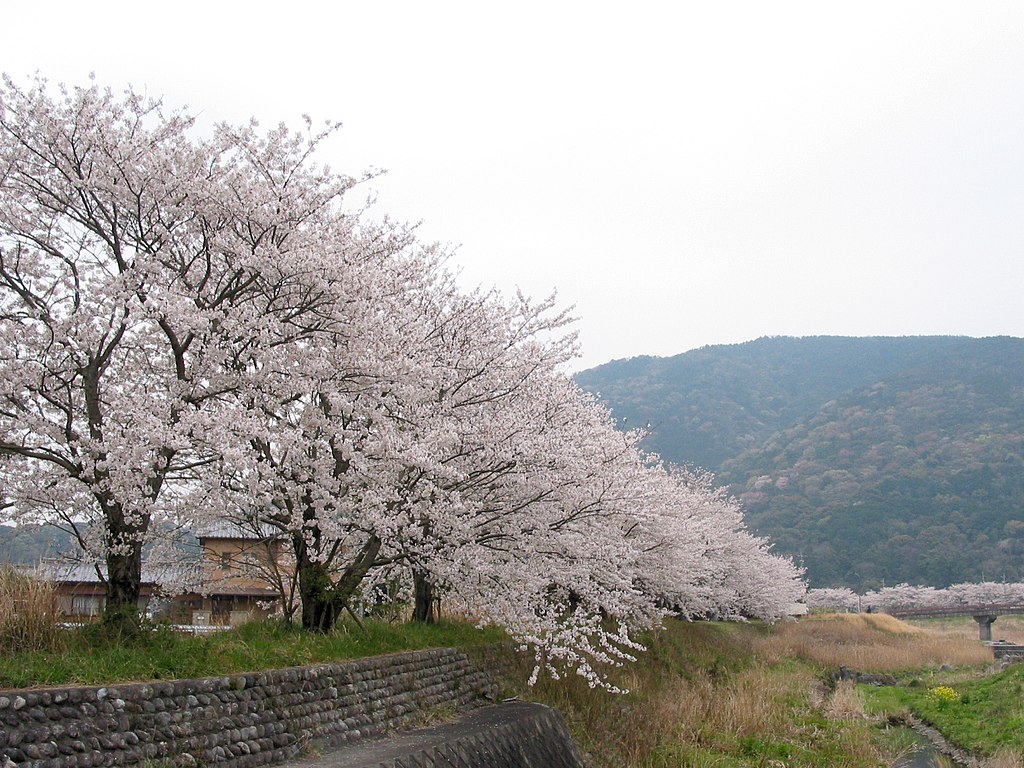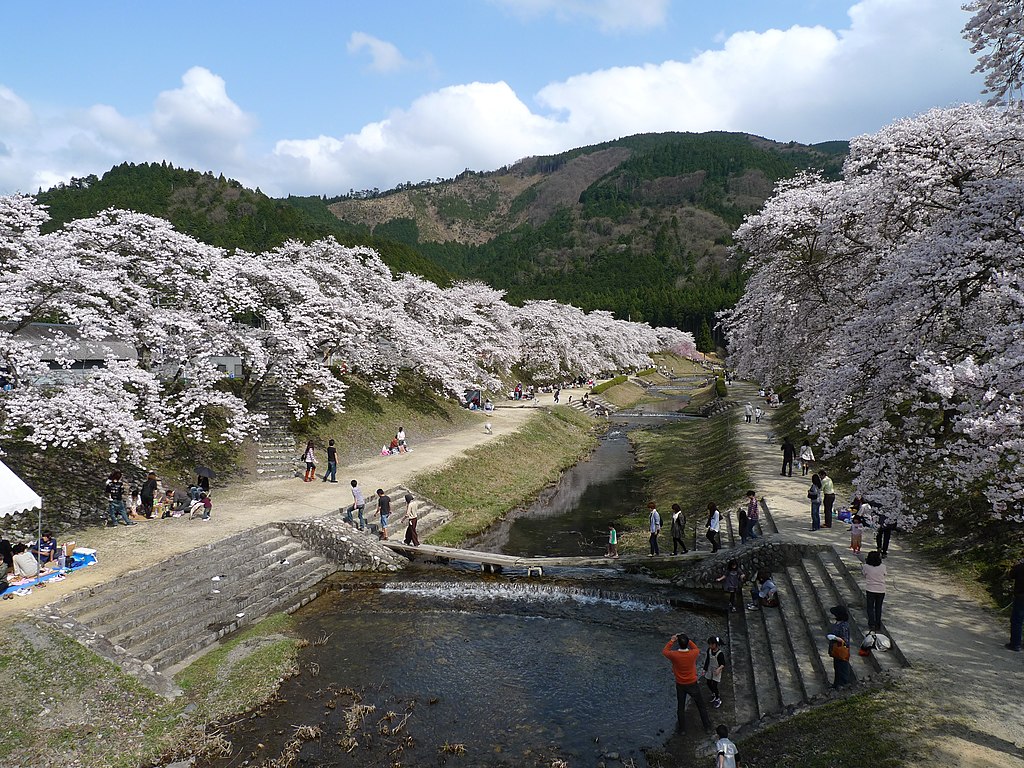Chapter 122 Prunus spp.
122.2 Soil: Moist Deciduous Mix
Ratio: 4 parts bark, 1 part grit
Add-ins: dolomitic limestone (LOW: ~2 lbs/yd), no additional nitrogen
pH: ~6.0 (mildly acidic)
122.3 Moisture
Flowering cherries like well drained soil with consistent watering during dry spells.
122.4 Light
Routine: All do best in full sun.
Summer: Mid-day shade can keep the leaves from burning out by August.
122.5 Cultivation Notes
122.5.1 Potting & Root Pruning
These trees naturally form dense mats of shallow fibrous roots that can block water penetration into the pots. The fine feeder roots will flatten and compact easily. Take extra time to work soil in and around the roots so they remain separated.
122.5.1.1 Top & Branch Management
Flowering cherries require regular pruning to maintain a healthy tree. In winter, prune out dead, damaged or diseased branches. Remove branches just outside the branch collar.
During the growing season, remove the current year’s old, faded flowers and any fruit clusters to encourage flower buds for the following season. Pinch back growing tips of extending shoots to encourage side branching.
Cherries do not heal over large wounds well, so it is a good practice to prune branches early, and develop large branch taper using a clip-and-grow strategy. Even with careful pruning, cherries tend to develop dead areas. Rather than trying to hide them, carve out the dead areas to create a feeling of greater age. If you need inspiration, search the web for photos of old cherry trees.
Avoid removing large branches, and start working branches when they are small. Large scars can be turned into uro cavities.
Fine branches that extend beyond the desired crown line can be cut back in mid-spring once leaves have expanded. Do not leaf prune, because it reduces the number of flowers, which are the focal point of these trees.
122.5.2 Feeding
Cherries are susceptible to both transplant shock and root burn. They should not be fed until 2 months after repotting. When repotting, use a free-draining bark rich soil that is slightly acidic, but not too high in nitrogen.
After the roots settle, flowering cherries can be fed with slow-releasing granular-type fertilizer such as 18-6-12 coated pellets, followed by half-strength Miracle Grow twice in summer. Never use quick-release fertilizers like 10-10-10 or lawn fertilizers.
122.5.3 Pests & Problems
Cherries are susceptible to a large number of insect and disease problems. Potential diseases include leaf spot, die back, leaf curl, powdery mildew, root rot and fireblight. Potential insects include aphids, scale, borers, leafhoppers, caterpillars, tent caterpillars and Japanese beetles. Spider mites may also attack the leaves.
Chemical Warnings
I have not seen any sensitivity to particular chemicals with this species. Most chemicals rated as safe for roses or cherries should be safe for this species.
122.5.4 Winter Storage
Store outdoors. Try to place in a shaded area so buds do not break in a mid-winter warm spell. Mulch thoroughly to minimize rapid changes in root temperature.
122.6 Propagation Notes
Like other ornamental trees, most commercially grown flowering cherries are propagated by grafting them onto sweet cherry rootstocks. When picking a starter tree, look very closely at the graft. The graft union can be quite obvious, and tends not to go away over time. Many Yoshino and Kanzan trees still have a distinctive scar more than 10 years after being planted out.
Weeping cherries often are propagated using what I call an “umbrella” graft. A standard cherry is grown to 8 feet tall, then cut back to 4 feet high. Ten-12 buds or short pieces of Higan branches are grafted on to form a mop head at the top of the straight trunk. Imagine an open umbrella with its handle stuck in a pot of soil, and you get the picture. These cannot be trained successfully for bonsai.
122.7 Artistic & Styling Notes
Mature flowering cherry trees growing in full sun naturally develop a broad, gnarled base with thick buttress roots. The trunk tapers and twists as it rises, disappearing into a cloud of flowers (in spring) and green leaves (in summer).

An old but well tended cherry tree stand at Isuzugawa-Tsutsumi, Japan. These trees show the form cherries take when growing naturally. Link to original image.
To develop this amount of taper, young stock trees will need to spend at least a few years in open ground. While they are in open ground, don’t remove side shoots from near ground level. They help to thicken the basal nebari. When pruned off, the small basal shoots will swell and further build up the gnarled shape of the base. Once the base is the size desired, cut off the trunk 1-3 inches below the desired height to allow space for new apical shoots to emerge.
122.8 Additional Information
One of my favorite times of the year is very early spring when the first cherry blooms open. Here in the Piedmont the first cherries to bloom are weeping cherries with single 5-petaled blossoms. As spring progresses and weeping cherries fade, there is a second wave of upright cherries with darker, 10-petaled flowers. The last wave of cherry blossoms look more like pompons than flowers, appearing as the oak and maple leaves open.
122.8.1 Natural History

Single white flowers of P. avium. Link to original image.
Ornamental cherries are members of the rose family. They are first cousins to apples, and more distantly, to blackberries and other thorny shrubs. There are members of the genus that are native to North America, including the wild plum (Prunus americana) common black cherry (P. serotina) and choke cherry (P. virginiana). However, all flowering cherries are natives of Asia.
Weeping or Higan cherries are the delicate, 5-petaled pink flowers that appear first each spring. They bloom on bare wood. This species is described in detail in a separate guide page.
Yoshino cherries are the next group to bloom. They also are the type sold most often commercially, and the type that most people think of when they hear cherry blossoms. Yoshino cherries are the main type planted in Washington, DC, and they are the focal point of festivals worldwide. P. speciosa is the main parent of this group, but most trees are classified as P. x yedoensis, a natural hybrid of P. speciosa and P. subhirtella. Literally hundreds of cultivars have been developed in this group. They are upright growing small trees with fragrant flowers ranging from single (5 petals) to double (10+ petals), in white to light pink.
Kanzan or Japanese cherry (P. serrulata) is another upright growing species. It is native to a wide range in China, Korea, and Japan,. The cultivar, ‘Kanzan,’ is widely misspelled as ‘Kwanzan.’ These are the large, showy, fully double cherries that are our last cherries to bloom in spring.

Pom-pom flowers of P. serrulata. Link to original image.
Taiwan cherries (Prunus campanulata) are less common, and different cultivars bloom throughout the season. They are small trees with dense branching, a graceful, spreading habit and a maximum height and width of 25 ft. They are native to southern China, Taiwan and Japan’s Ryukyu Islands. This is the only group that tolerates much shade. They also are the most heat-tolerant species.
The bark is smooth and reddish brown. Deep rosy-pink, bell-shaped flowers, about an inch across, appear in profusion before the leaves. They bear small cherries, 1/8” in diameter, ripening to black. Unlike Higan cherry or Yoshino, the flowers tend to be more bell-like, with deeper throats. The cultivar ‘Okame’ is a product of a cross with P. incisa; it has deep red flowers and brilliant orange autumn foliage.
122.8.2 In Cultivation
Called sakura in Japan, flowering cherries have a complicated natural and political history. They were popularized during the Heian Period (794–1191), when the Japanese adopted the Chinese practice of hanami (flower viewing). The imperial household, poets, singers and other aristocrats would gather and celebrate under the blossoms. In Japan, cherry trees were planted and cultivated for their beauty, for the adornment of the grounds of the nobility of Kyoto, at least as early as 794. In China, the ume “plum” tree was preferred, but by the middle of the ninth century, the cherry blossom had become the favored species in Japan. They are admired as a metaphor for the fleeting nature of life, and like flowering apricots, rebirth after the winter.

Cherry blossom viewing at Aiga. This is a common pasttime for families in spring in Japan. Link to original image.
Flowering cherries were first brought to the US around 1900, when Dr. David Fairchild, an officer of the USDA, ordered trees for test plantings in Washington, DC. They were formally introduced in 1912 when the Japanese government presented them as a gift. Unfortunately when the trees arrived the quarantine officers claimed they were infested with insects and they were burned. The trees had passed Japanese certification upon departure, and it has been long suspected that they were destroyed because many Washingtonians wanted only native trees in the capital. An international incident almost erupted, but eventually subsided when a subsequent shipment arrived safely. First Lady Helen Taft and the wife of the Japanese ambassador planted the first two of 3020 trees in the tidal basin. These first two trees are still alive and marked with plaques. However most of the other original trees were removed to make way for the Jefferson Memorial, and others were killed in protest of the Japanese attack on Pearl Harbor. The majority of the flowering cherries in the Tidal Basin of Washington, DC today were planted much later.

Close-up of single blossoms on a tree in Shiroyama Park, Gifu Prefecture, Japan. Link to original image.
After their rocky start, flowering cherries have thrived in the US. Trees grown from cuttings and grafts of the original gift trees, as well as later cultivars developed in Japan and here have become a staple in the horticultural and landscaping industry.
